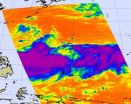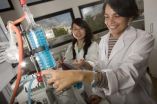(Press-News.org) Patients suffering REM sleep behaviour disorders dream nightmares in which they are attacked and pursued, with the particularity that they express them by screaming, crying, punching and kicking while sleeping. Lancet Neurology has published the third consecutive work in five years about the relationship between this disorder and Parkinson's disease. The first work showed in 2006 that 45% of patients who suffer this sleep disorder develop Parkinson's disease and other neurodegenerative diseases caused by a lack of dopamine in the brain. The second article discovered that neuroimaging tests that measure dopamine in the brain, such as the brain SPECT, are useful to identify patients with REM sleep disorders with increased risk of developing a neurodegenerative diseases such as Parkinson's disease.
The new study applied brain SPECT to conclude that the levels of dopamine in the brain are quickly lowering over the years in patients with REM sleep behaviour disorder. This neuroimaging technique becomes the first tool to detect the disease progression at an early stage. The first author of the three articles is Dr. Àlex Iranzo, doctor from the Neurology Service at the Hospital Clínic of Barcelona, researcher at the Biomedical Research Institute of August Pi i Sunyer (IDIBAPS) and member of the Multidisciplinary Sleep Disorders Unit , and the senior authors were to Dr. Joan Santamaria and Dr. Eduard Tolosa, from the same institution.
The study involved comparing for three years the evolution of brain SPECT in 20 patients with REM disorder and 20 healthy controls. The neuroimaging technique measures the presence of dopamine in the substantia nigra, a part of the brain associated with learning and harmony of body movements. In Parkinson's disease a deficiency of dopamine in the substantia nigra causes tremor, stiffness and movement slowness in patients. Results show that after 3 years of monitoring the production of dopamine in the control group was reduced by 8% due to age, while the group of REM sleep disorder patients experienced a reduction of 20%. Once the 3 year follow-up ended, 3 of 20 patients in the REM sleep disorder group had developed Parkinson's disease and their dopamine reduction was around 30%.
The three works led by the IDIBAPS - Hospital Clínic of Barcelona team conclude that more efforts are needed to create neuroprotective drugs that prevent the progression from REM sleep behavior disorders to Parkinson's disease. For the first time scientists have a technique, brain SPECT, to evaluate whether these drugs are effective. Authors of the study suggest that, to be considered effective, a neuroprotective drug should significantly prevent the dopamine concentration from dropping in these patients.
INFORMATION:
REM sleep behavior disorder is a risk factor for Parkinson's disease
For the first time scientists have a technique, brain SPECT, to evaluate whether neuroprotective drugs are effective
2011-08-01
ELSE PRESS RELEASES FROM THIS DATE:
Penn chemists make first molecular binding measurement of radon
2011-08-01
PHILADELPHIA — Even in trace quantities, the radioactive gas radon is very dangerous; it is second only to cigarette smoking as a cause of lung cancer deaths in the United States. The expense and precautions necessary to study it safely have limited research into its properties. Now, University of Pennsylvania chemists have for the first time measured how well radon binds to a molecule, paving the way for future research on it and other noble gasses.
The research was led by associate professor Ivan J. Dmochowski, along with undergraduate Vagelos Scholar David R. ...
Tropical Storm Muifa appears huge on NASA infrared imagery
2011-08-01
The width of an image from the AIRS instrument that flies on NASA's Aqua satellite is about 1700 km (1056 miles), and the clouds and thunderstorms associate with Tropical Storm Muifa take up that entire distance on today's imagery.
Tropical Storm Muifa is spinning through the western North Pacific Ocean today and has grown in size. When NASA's Aqua satellite passed over the storm on July 29, 2011 at 04:17 UTC (12:17 a.m. EDT) it measured the temperatures in the cloud tops. Those cloud top temperatures especially in the east and western sides of the tropical storm were ...
Tropical Storm Don analyzed in 3 NASA satellite images
2011-08-01
NASA is analyzing Tropical Storm Don from all angles, inside and out, using three different satellites. Don is expected to make landfall in southeastern Texas tonight or early Saturday.
NASA's Aqua satellite passed over Tropical Storm Don at 8:17 UTC (4:17 a.m. EDT) on July 29. The instrument called the Atmospheric Infrared Sounder (AIRS) took the temperature of Don's clouds in an infrared image. AIRS data revealed a large area of powerful, high thunderstorms with cold cloud tops surrounding Don's center where cloud temperatures were colder than -63 Fahrenheit (-52 Celsius). ...
AGU journal highlights -- July 29, 2011
2011-08-01
The following highlights summarize research papers that have been
recently published in Geophysical Research Letters (GRL); Space
Weather; Geochemistry, Geophysics, Geosystems (G-Cubed); Journal of Geophysical Research-Biogeosciences (JGR-G); Journal of Geophysical Research-Earth Surface (JGR-F); Journal of Geophysical Research-Space Physics (JGR-A) and Water Resources Research (WRR).
In this release:
What do sea measurements reveal about Earth's temperature trend?
Japan's big earthquake shook the ionosphere
Miniature detector measures deep space radiation
New ...
Computational chemistry shows the way to safer biofuels
2011-08-01
Replacing gasoline and diesel with plant-based bio fuels is crucial to curb climate change. But there are several ways to transform crops to fuel, and some of the methods result in bio fuels that are harmful to health as well as nature.
Now a study from the University of Copenhagen shows that it is possible to predict just how toxic the fuel will become without producing a single drop. This promises cheaper, faster and above all safer development of alternatives to fossil fuel.
Solvejg Jorgensen is a computational chemist at the Department of Chemistry in Copenhagen. ...
Discovery of a new magnetic order
2011-08-01
Physicists at Forschungszentrum Jülich and the universities of Kiel and Hamburg are the first to discover a regular lattice of stable magnetic skyrmions – radial spiral structures made up of atomic-scale spins – on a surface instead of in bulk materials. Such tiny formations could one day form the basis of a new generation of smaller and more efficient data storage units in the field of information technology. The scientists discovered the magnetic spirals, each made up of just 15 atoms, in a one-atomic-layer of iron on iridium. They present their results in the current ...
National asthma genetics consortium releases first results
2011-08-01
A new national collaboration of asthma genetics researchers has revealed a novel gene associated with the disease in African-Americans, according to a new scientific report.
By pooling data from nine independent research groups looking for genes associated with asthma, the newly-created EVE Consortium identified a novel gene association specific to populations of African descent. In addition, the new study confirmed the significance of four gene associations recently reported by a European asthma genetics study.
The findings, published in Nature Genetics, are a promising ...
Physics could be behind the secrets of crop-circle artists
2011-08-01
In this month's edition of Physics World, Richard Taylor, director of the Materials Science Institute at the University of Oregon, takes a serious, objective look at a topic that critics might claim is beyond scientific understanding – crop circles.
As the global crop-circle phenomenon grows alongside advances in science and technology, Taylor notes how physics and the arts are coming together to produce more impressive and spectacular crop-circle patterns that still manage to maintain their mystery.
Today's crop-circle designs are more complex than ever, with some ...
Dissecting the genomes of crop plants to improve breeding potential
2011-08-01
Scientists on the Norwich Research Park, working with colleagues in China, have developed new techniques that will aid the application of genomics to breeding the improved varieties of crop needed to ensure food security in the future. By dissecting the complicated genome of oilseed rape they have been able to produce maps of the genome that are needed for predictive breeding.
Traditional breeding involves crossing two varieties and selecting the best performing among the progeny. Predictive breeding is a more advanced technique where specific parts of the genome most ...
Columbia engineering innovative hand-held lab-on-a-chip could streamline blood testing worldwide
2011-08-01
New York, NY—July 31, 2011—Samuel K. Sia, assistant professor of biomedical engineering at Columbia Engineering, has developed an innovative strategy for an integrated microfluidic-based diagnostic device—in effect, a lab-on-a-chip—that can perform complex laboratory assays, and do so with such simplicity that these tests can be carried out in the most remote regions of the world. In a paper published in Nature Medicine online on July 31, Sia presents the first published field results on how microfluidics—the manipulation of small amounts of fluids—and nanoparticles can ...
LAST 30 PRESS RELEASES:
Making lighter work of calculating fluid and heat flow
Normalizing blood sugar can halve heart attack risk
Lowering blood sugar cuts heart attack risk in people with prediabetes
Study links genetic variants to risk of blinding eye disease in premature infants
Non-opioid ‘pain sponge’ therapy halts cartilage degeneration and relieves chronic pain
AI can pick up cultural values by mimicking how kids learn
China’s ecological redlines offer fast track to 30 x 30 global conservation goal
Invisible indoor threats: emerging household contaminants and their growing risks to human health
Adding antibody treatment to chemo boosts outcomes for children with rare cancer
Germline pathogenic variants among women without a history of breast cancer
Tanning beds triple melanoma risk, potentially causing broad DNA damage
Unique bond identified as key to viral infection speed
Indoor tanning makes youthful skin much older on a genetic level
Mouse model sheds new light on the causes and potential solutions to human GI problems linked to muscular dystrophy
The Journal of Nuclear Medicine ahead-of-print tip sheet: December 12, 2025
Smarter tools for peering into the microscopic world
Applications open for funding to conduct research in the Kinsey Institute archives
Global measure underestimates the severity of food insecurity
Child survivors of critical illness are missing out on timely follow up care
Risk-based vs annual breast cancer screening / the WISDOM randomized clinical trial
University of Toronto launches Electric Vehicle Innovation Ontario to accelerate advanced EV technologies and build Canada’s innovation advantage
Early relapse predicts poor outcomes in aggressive blood cancer
American College of Lifestyle Medicine applauds two CMS models aligned with lifestyle medicine practice and reimbursement
Clinical trial finds cannabis use not a barrier to quitting nicotine vaping
Supplemental nutrition assistance program policies and food insecurity
Switching immune cells to “night mode” could limit damage after a heart attack, study suggests
URI-based Global RIghts Project report spotlights continued troubling trends in worldwide inhumane treatment
Neutrophils are less aggressive at night, explaining why nighttime heart attacks cause less damage than daytime events
Menopausal hormone therapy may not pose breast cancer risk for women with BRCA mutations
Mobile health tool may improve quality of life for adolescent and young adult breast cancer survivors
[Press-News.org] REM sleep behavior disorder is a risk factor for Parkinson's diseaseFor the first time scientists have a technique, brain SPECT, to evaluate whether neuroprotective drugs are effective




